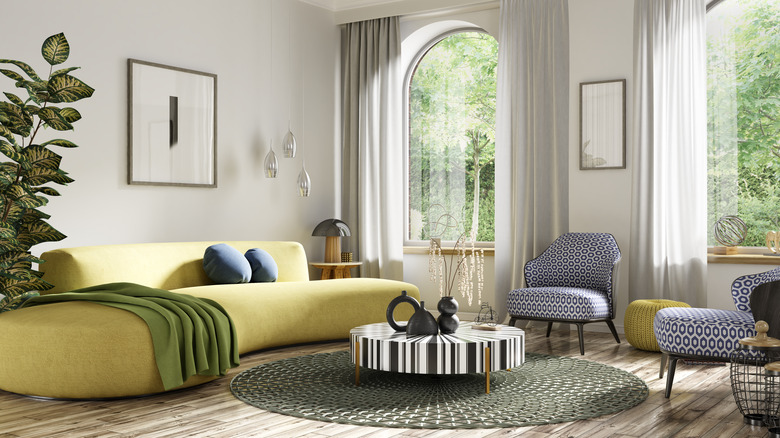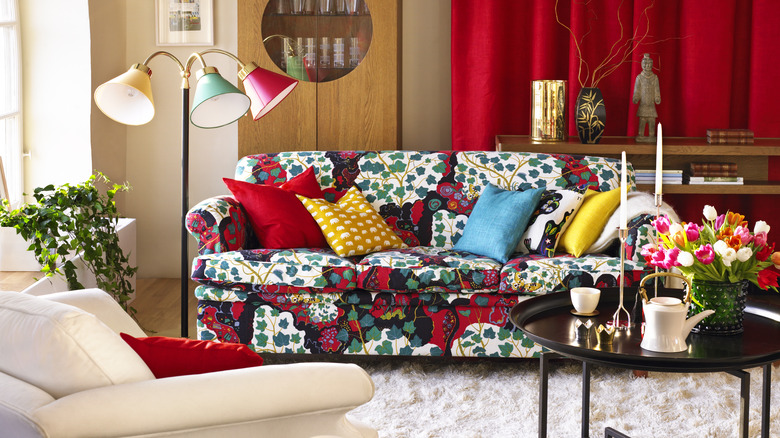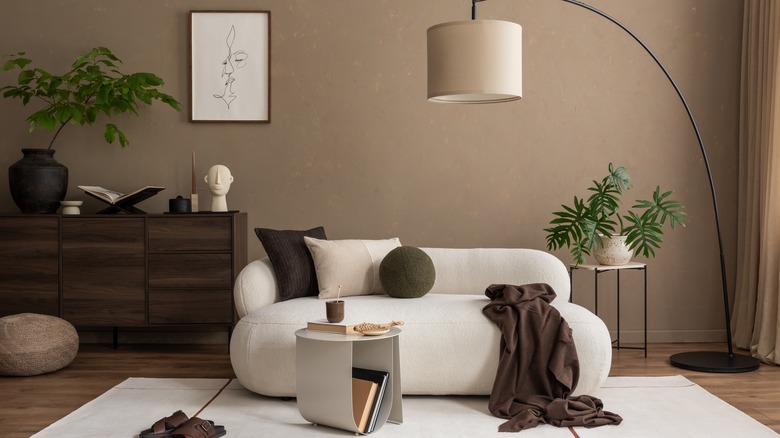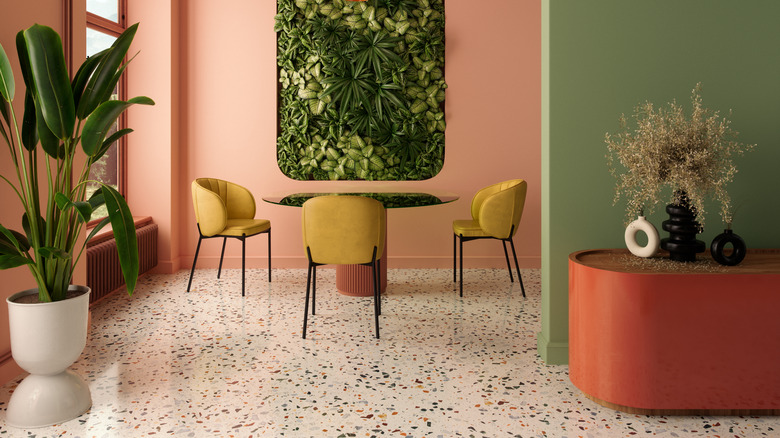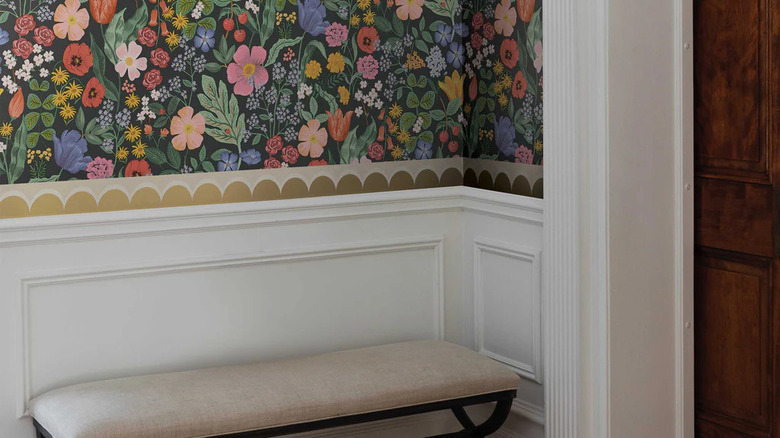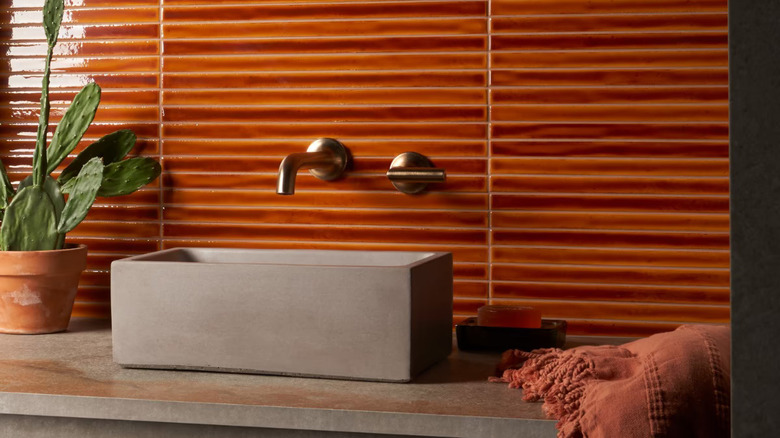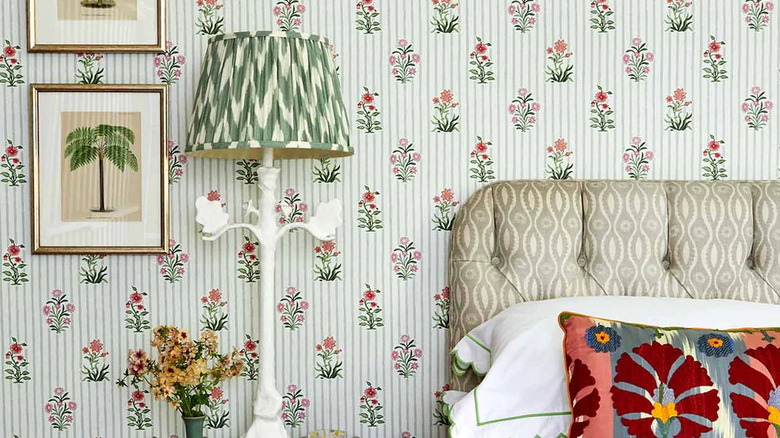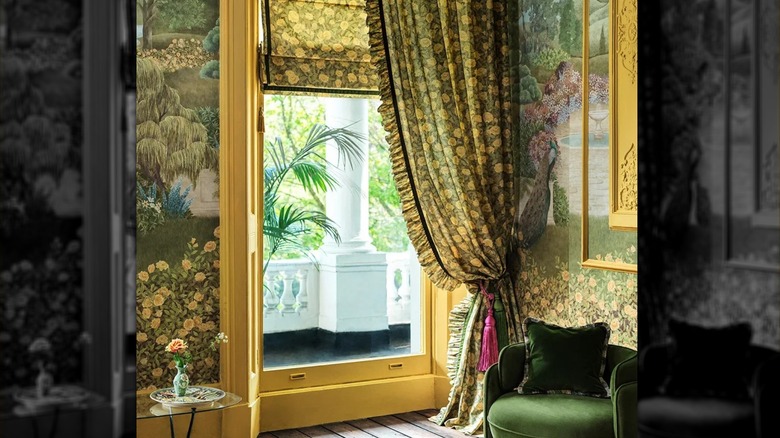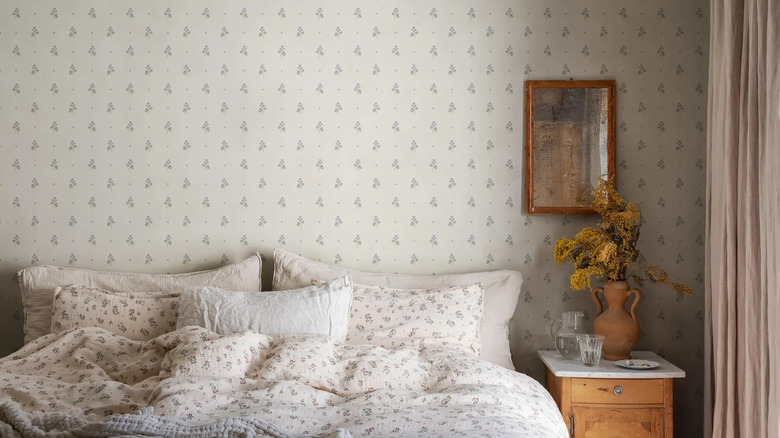Unexpected '90s Design Trends That Are Making A Bold Comeback In Homes Everywhere
While we love to declutter and remove old, dated items from our homes, trends are pretty cyclical, and what was once old often becomes new again. This is especially true with '90s design trends making a bold comeback this year, signaling a shift away from our obsession with modern and contemporary styles. Recently, there has been a concentrated push to move beyond the neutral, design-safe accents of farmhouse and minimalism in favor of something a little more eclectic and lived-in.
For many people, '90s designs either remind them of their childhoods or early adulthood, giving that decade a special place in their hearts. Things like floral wallpaper and bold colors might remind you of the safe haven of your mother's bedroom or the lively space of your first apartment, and getting to incorporate that into your home will make you nostalgic. But it's not just sentimentality driving these maximalist trends back into view. There are a lot of different forces at play here, from craving something less cookie-cutter to wanting to bring more of nature indoors. Here is a detailed look into which '90s trends are having a comeback, and why people are embracing them with a new vigor.
Bold colors and high contrast are having a moment
There was nothing minimalist about 1990s interior design. Instead, people gravitated toward bold colors and vibrant settings, using loud hues in ways that are rare today. Just think back to the apartments in some of your favorite TV shows from that era. For instance, Monica Geller on "Friends" had periwinkle purple walls in her living room, whereas Khadijah, Synclaire, and Regina on "Living Single" had raspberry red walls and chartreuse green curtains. As it turns out, that need for color is coming back around. "In the '90s, we saw a love for vibrant, bold colors — think jewel tones like emerald greens, sapphire blues, and deep purples. This trend is making a comeback as people seek to add personality and drama to their spaces after a decade of minimalist, neutral palettes," Bilal Rehman, CEO and Principal Designer of Bilal Rehman Studio and Founder of Bilal Rehman Gallery, exclusively tells House Digest.
But it's not just about seeking something different from the earth tones of modern farmhouse and minimalist designs. This trend is returning because there is a desire to break away from the cookie-cutter and fad-driven homes we created in order to share them on places like Instagram. "Bold colors create a statement, and in today's design world, there's a strong desire for self-expression, which is why these rich, high-contrast hues are being reintroduced," Rehman explains. After a decade of Millennial gray and the black and white palette of modern farmhouse, more people are finding these styles reminiscent of sterile showrooms and are instead seeking to infuse their spaces with personality and uniqueness.
Curved furniture brings an organic touch to the room
There has also been an emphasis on strong, linear furniture in the last decade. Modern farmhouse utilized large, boxy sofas with straight backs, rectangular coffee tables, and oversized dining tables used to encourage gathering. However, there is now a push for the polar opposite of that. "Furniture with soft, rounded edges was a staple in '90s homes, and it's back in style. Curved sofas, arched doorways, and rounded tables are all trending again," Rehman shares. A glance at the catalogs of popular furniture stores like CB2 and West Elm shows a wide array of organic shapes, from amorphous side tables to puddle-like mirrors.
"This resurgence is largely due to the shift towards creating more welcoming and comfortable environments," Rehman notes. "The softness of curved lines adds a sense of warmth and sexiness to interiors, which is especially appealing in a world that's increasingly focused on well-being and comfort at home." This focus on comfort also goes hand-in-hand with the rising biophilic design, which focuses on bringing nature indoors. As working from home and living a large chunk of our lives online has become the norm, there is a growing desire to balance this with a connection to nature. This is reflected in the soft shapes of furniture (since straight lines and angles are rare in the natural world,) natural textures, and earthy yet highly pigmented colors.
Terazzo adds some texture to the space
Speaking of natural textures, terrazzo has been having something of a comeback these last several years. "Terrazzo, a composite material made of chips of marble, quartz, granite, or glass, set in concrete, was popular in the '90s, particularly in flooring," Rehman shares. "It's making a comeback not only in floors but also in countertops, backsplashes, and even home decor." Terrazzo offers a fun and playful way to introduce color and texture to a room, with its distinctive flakes allowing for customization. You can opt for contrasting colors or adjust the boldness of the look by choosing the size of the chips.
It's making a comeback for several reasons. "Its resurgence is tied to the broader trend of embracing retro styles and sustainable materials. Terrazzo's durability and customizable appearance make it a favorite for those looking to add a unique, textural element to their homes," he explains. The '50s and '70s are having something of a resurgence, especially their earthier, nature-focused trends. Just look at the premiere of "Fixer Upper: The Lakehouse" in 2024. The Gaineses traded in their farmhouse aesthetic to embrace an organic, mid-century design in their retro vacation home. (In fact, they used white terrazzo floors in the entry!) The flooring not only brings in a touch of nature indoors — especially when paired with other earthy elements like wood paneling walls — but also gives a nod to sustainability, which is another major factor of the biophilic trend. It uses repurposed glass or stone chips, giving a second life to something that might have been tossed out.
Wallpaper borders are a fun way to clash
You might remember wallpaper borders from your childhood home, adorning the edges of your parent's living rooms. These decorative strips added a touch of pattern to the space where the wall meets the ceiling. "Wallpaper borders were a quintessential '90s trend, often used to add a decorative touch to rooms without committing to full-wall wallpaper," Rehman explains. "While they fell out of favor for a time, they're now back as part of the maximalist trend." As more people experiment with rooms packed with personality and novelty, these borders are a perfect way to try out contrasting designs or vibrant colors without getting too loud.
"Homeowners are increasingly embracing bold patterns and intricate details, and wallpaper borders offer a way to experiment with these elements in a more controlled, subtle manner," Rehman points out. You can even make it a temporary experiment if you use a peel-and-stick version, allowing you to play with different motifs until you find the best one for your home. If you like the idea of this trend but it reminds you of your mother's house too much, you can also use it in new and unexpected ways. For instance, rather than lining the ceiling with it, try outlining a fireplace mantel, door frame, or chair rail instead.
Colorful bathrooms are creating daring spaces
Living rooms weren't the only place packed with color in the '90s. People also loved to get playful with their bathroom designs. "While much of the '90s was about excess, there was also a strong color movement, particularly in bathroom design. Bold colors, fun patterns, and mixed tiling were key," Rehman notes. "This trend has returned as part of the eclectic and maximalist style." Just think of all of the brass fixtures, coral tiles, and kitschy wallpaper in the '90s houses you went to look at during open houses. Being bold was the name of the game.
While you might not put up a seashell-shaped sconce in your primary bathroom anytime soon, there is a noticeable shift towards creating a more playful and mixed-medium aesthetic in these spaces. "People are looking for their bathrooms to be fun and unique rather than the minimal spa-like bathroom concepts we've been seeing the past few years," Rehman explains. If you're tired of the usual white, gray, and gray blue color options, dive into something a little richer. Unique tile installations are trending, where you choose multi-colored tiles in the same color family and lay them in unique configurations. Rather than just relying on horizontal white subway tiles, you can choose thin Zelig tiles in four different shades of green and have them installed in a zigzag shape. Terrazzo and marble is also trending in shower surrounds, and is often paired with contrasting flooring for a maximalist touch.
Laura Ashley inspired wallpaper provides a cozy touch
Wallpaper borders aren't the only thing making a comeback in 2024. Full-on wallpapered rooms are also gaining popularity, with one style in particular making its way into the mainstream: Laura Ashley-inspired wallpaper. Laura Ashley was a Welsh designer known for her Victorian-inspired dresses and textiles that featured a wash of tiny flowers. She also made wallpaper and furnishing in the same style, and the look quickly became synonymous with the timeless, British aesthetic. Now, as wallpaper experiences a resurgence, the appeal of the tiny floral print is also on the rise.
That's because it seamlessly fits into a list of trends that are taking off this year, from maximalist to biophilic to cottagecore. The tiny print creates a busy background, allowing you to contrast color and larger prints against it. It's also much different from the floral wallpapers we have grown accustomed to in the last decade, which featured larger blooms for a more contemporary take. But even though it's busy, it still feels comforting and cozy thanks to its nature-inspired design. It helps to bring the outside in, which is exactly what people are looking for right now.
Wallpaper that matches the curtains and bedding creates a cocooning effect
This one might be a little harder to pull off because it will most likely require you to order fabric and then commission the set, but matching your wallpaper to your bedding and curtains is taking off in a big way this year. This fits in with the maximalist rise of recent years, enveloping an entire room in a busy print. It's a far cry from the neutral, hotel-like bedroom designs of recent years, which focused on airy colors and calming designs.
This not only fits in with rising micro-trends like grandpa core and cottagecore, but it also fits in with our need to cocoon. Since the pandemic, more and more people have turned their homes into their havens, and they have created a sense of envelopment with tricks like color-drenching, which paints the walls, ceiling, and trim the same color, as well as cocooning, which uses the same color on the walls, furniture, and decor. By matching your wallpaper with your curtains and bedding, you create the same vibe. You can do this the custom route by ordering wallpaper and matching fabric from places like Jane Clayton. You can then either try to DIY your bedding and window treatments, or take them to a professional.
Nancy Meyers-inspired homes are wonderfully eclectic
Nancy Meyers is known for her cozy, coastal, lived-in aesthetics, as is evidenced by the timeless but homey spaces in movies like "The Parent Trap" and "Father of the Bride." These retro homes are having something of a moment right now, especially when it comes to Pinterest mood boards. According to a trend report by the platform, the term "Nancy Meyers homes" went up 2,055% in the summer of 2024, with "Nancy Meyers living room" being the most popular, with an increase of 2,090%.
This trend in particular is taking off because people are becoming more drawn to eclectic, vintage designs that are unique rather than cookie-cutter. In fact, "vintage eclectic home" increased in searches by 1,418%. The last 10 years were dominated by HGTV trends like farmhouse and transitional, and once designers like Joanna Gaines and Shea McGee got partnerships with big box stores like Target, it was super easy to copy. Now it feels like everyone's homes look the same, so by looking to create vintage spaces, you're guaranteeing your room will look one-of-a-kind and can't be replicated.
